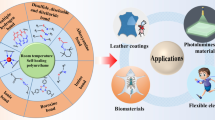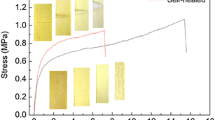Abstract
Poly(ethylene-co-vinyl acetate) with 42 wt% of vinyl acetate shows autonomic self-healing at room temperature without macroscopic flow. Intermolecular diffusion of amorphous chains through the jointed boundary, which occurs because of the large amount of amorphous chains with low glass transition temperature, is responsible for the healing phenomenon. Furthermore, the healing efficiency is found to be enhanced when the separated pieces are recombined immediately after cutting. This result indicates that the cut surface has marked molecular mobility owing to the destruction of crystallites during the cutting process, which is supported by differential scanning calorimetry (DSC) measurements. The marked molecular mobility at the surface is, however, observed only for a short period after cutting, because further crystallization after cutting restricts the molecular motion.








Similar content being viewed by others
References
Wool RP (1994) Polymer interfaces: structure and strength. Hanser Gardener, Cincinnati
Wool RP (2008) Self-healing materials: a review. Soft Matter 4:400–418
Wu DY, Meure S, Solomon D (2008) Self-healing polymeric materials; a review of recent developments. Prog Polym Sci 33:479–522
Blaszik BJ, Kramer SLB, Olugebefola SC, Moore JS, Sottos NR, White SR (2010) Self-healing polymers and composites. Annu Rev Mater Res 40:179–211
Murphy B, Wudl F (2010) The world of smart healable materials. Prog Polym Sci 35:223–251
Zhang MQ, Rong MZ (2010) Self-healing polymers and polymer composites. Wiley, New York
Yamaguchi M, Maeda R, Kobayashi R, Wada T, Ono S, Nobukawa S (2012) Autonomic healing and welding by interdiffusion of dangling chains in weak gel. Polym Int 61:9–16
Binder WH (2013) Self-healing polymers, from principles to applications. Wiley-VCH, Weinheim
Yamaguchi M, Ono S, Terano M (2007) Self-repairing property of polymer network with dangling chains. Mater Lett 61:1396–1399
Yamaguchi M, Ono S, Okamoto K (2009) Interdiffusion of dangling chains in weak gel and its application to self-repairing material. Mater Sci Eng B 162:189–194
Summers JW (1981) The nature of poly(vinyl chloride) crystallinity—the microdomain structure. J Vinyl Technol 3:107–110
Yamaguchi M (2001) Flow instability in capillary extrusion of plasticized poly(vinyl chloride). J Appl Polym Sci 82:1277–1283
Nobukawa S, Shimada H, Aoki Y, Miyagawa A, Doan VA, Yoshimura H, Tachikawa Y, Yamaguchi M (2014) Extraordinary wavelength dispersion of birefringence in cellulose triacetate film with anisotropic nanopores. Polymer 55:3247–3253
Yamaguchi M, Wakabayashi T (2006) Rheological properties and processability of chemically modified poly(ethylene terephthalate-co-ethylene isophthalate). Adv Polym Technol 25:236–241
Yamaguchi M, Wakabayashi T, Kanoh T (2008) Effect of mixing conditions on rheological and optical properties for chemically modified poly(ethylene terephthalate-co-ethylene isophthalate). J Appl Polym Sci 107:2665–2670
Rujirek W, Hachiya Y, Endo T, Nobukawa S, Yamaguchi M (2015) Anomalous transfer phenomenon of carbon nanotube in the blend of poly(ethylene terephthalate) and polycarbonate. Compos Part B 78:409–414
Yamane H, Sakai K, Takano M, Takahashi M (2004) Poly(D-lactic acid) as a rheological modifier of poly(L-lactic acid): shear and biaxial extensional flow behavior. J Rheol 48:599–609
Jimenez A, Peltzer M, Ruseckaite R (2014) Poly(lactic acid) science and technology: processing, properties, additives, and applications. Royal Society of Chemistry, Oxfordshire
Salyer IO, Kenyon AS (1971) Structure and property relationships of ethylene-vinyl acetate copolymers. J Polym Sci Part A-1(9):3083–3103
Shankernarayanan MJ, Sun DC, Kojima M, Magill JH (1987) Rolletrusion: doubly-orientation processing and morphology—property relationships for commercial plastics. Int Polym Proc 1:66–76
Arsac A, Carrot C, Guillet J (1999) Rheological characterization of ethylene vinyl acetate copolymer. J Appl Polym Sci 74:2625–2630
Dlubek G, Lpke T, Stejny J, Alam MA, Arnold M (2000) Local free volume in ethylene-vinyl acetate copolymers: a positron lifetime study. Macromolecules 33:990–996
Peacock AJ (2000) Handbook of polyethylene. Marcel Dekker, New York
Takahashi S, Okada H, Nobukawa S, Yamaguchi M (2012) Optical properties of polymer blends composed of poly(methyl methacrylate) and ethylene-vinyl acetate copolymer. Eur Polym J 48:974–980
Yamaguchi M, Arakawa K (2007) Control of structure and mechanical properties for binary blends of poly(3-hydroxybutyrate) and cellulose-derivative. J Appl Polym Sci 103:3447–3452
Huang T, Miura M, Nobukawa S, Yamaguchi M (2014) Crystallization behavior and dynamic mechanical properties of poly(L-lactic acid) with poly(ethylene glycol) terminated by benzoate. J Polym Environ 22:183–189
Zhu L (1999) In: Brandrup J, Immergut EH, Grulke EA (eds) Polymer handbook, V/9-19, 4th edn. Wiley Interscience, New York
Ferry JD (1980) Viscoelastic properties of polymers, 3rd edn. Wiley, New York
Wunderlich B (1980) Macromolecular physics, vol. 3, crystal melting. Academic, New York
Rodriguez-Cabello JC, Alonso M, Merino JC, Pasor JM (1996) Scanning electron microscopy and differential scanning calorimetry study of the transition front in uniaxially stretched isotactic polypropylene. J Appl Polym Sci 60:1709–1717
Acknowledgments
This work was promoted by COI program “Construction of next-generation infrastructure system using innovative materials”—realization of safe and secure society that can coexist with the Earth for centuries—supported by the Japan Science and Technology Agency (JST). Further, a part of this study was supported by Grand-in-Aid for Scientific Research No. 25410221.
Author information
Authors and Affiliations
Corresponding author
Ethics declarations
Conflict of interest
The authors declare that they have no competing interests.
Electronic supplementary material
Below is the link to the electronic supplementary material.
Supplementary information 1
Schematic illustration of the sample preparation procedures for the DSC surface crystallinity evaluation measurements: (a) a large piece measuring 3 × 3 × 1.1 mm3 was cut out from the compressed sheet and kept at 25 °C for 64 h prior to the measurement, (b) 30 small pieces each with dimensions of 0.7 × 0.7 × 0.7 mm3 were cut from the compressed sheet and used immediately after cutting, and (c) the small pieces were kept at 25 °C for 64 h prior to the measurement. (GIF 90 kb)
Supplementary information 2
Schematic illustration of molecular chains after cutting (GIF 89 kb)
Rights and permissions
About this article
Cite this article
Osato, R., Sako, T., Seemork, J. et al. Self-healing properties of poly(ethylene-co-vinyl acetate). Colloid Polym Sci 294, 537–543 (2016). https://doi.org/10.1007/s00396-015-3817-z
Received:
Revised:
Accepted:
Published:
Issue Date:
DOI: https://doi.org/10.1007/s00396-015-3817-z




